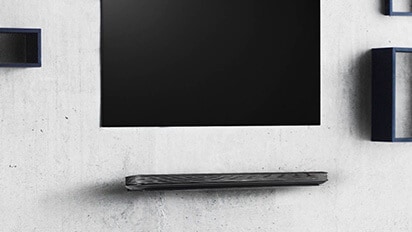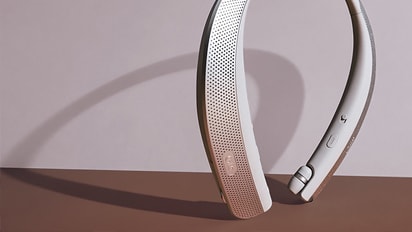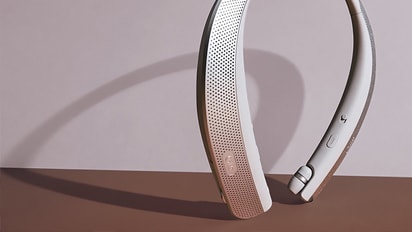Your LG Chromebase Monitor features USB, HDMI, and Gigabit Ethernet inputs, as well as a 3.5mm(headphone/computer speaker) output. The system also contains Bluetooth® wireless technology. Using these ports you can connect some of your peripheral devices to enjoy them with your Chromebase.
Note: Some USB devices may not be compatible.
HDMI (High-Definition Multimedia Interface) is a method of transmitting sound and video from your computer's (or other HDMI enabled device) HDMI-Out port to your Chromebase monitor's HDMI-In port.
Note: Chromebase does not support projecting to a second monitor. The HDMI port is strictly for input.
To connect your HDMI device to your Chromebase monitor:
- Make sure both the HDMI device and the monitor are powered On.
- Connect an HDMI cable from the HDMI-Out port on your HDMI device, to the HDMI-In port on your monitor.
- Locate and press the Chrome button on the front-bottom-right of your Chromebase to switch the input source.
USB is a common connection type used for external hard drives/flash drives, cameras, smart phones/tablets, and Mice/Keyboards. Chrome OS does not support all devices, especially those devices with advanced features requiring drivers. Chrome OS does not currently support drivers, so only plug-and-play style peripherals are supported.
Below is a list of device types and requirements. This list is not all inclusive, and support for new devices may be added by Google at any time. To get the most up-to-date information, visit Google's Chromebook Support Article: Supported file types and external devices.
-
Supported File Types
- Microsoft Office files - .doc, .docx, .xls, .xlsx, .ppt (read-only), .pptx (read-only)
- Music/Videos - .3gp, .avi, .mov, .mp4, .m4v, .m4a, .mp3, .mkv, .ogv, .ogm, .ogg, .oga, .webm, .wav
- Pictures - .bmp, .gif, .jpg, .jpeg, .png, .webp
- Compressed files - .zip, .rar
- Other files - .txt, .pdf (read-only)
-
Supported Codecs
- ogv - Video: (Theora), Audio: ()
- webm - Video: (VP8, VP9), Audio: (Opus, Vorbis)
- mp4 - Video: (H.264, MPEG4), Audio: ()
- mov - Video: (H.264, MPEG4), Audio: ()
- avi - Video: (MPEG4, DIVX, XVID), Audio: (MP3)
- 3gp - (Video: H.264, Audio: AAC), (Video: MPEG4, Audio: AMR-NB)
-
Supported Filesystems (External Drives)
- Ext2
- Ext3
- Ext4
- MTP (read-only)
- FAT (FAT16, FAT32, exFAT)
- HFS+ (read-only on journaled HFS+)
- ISO9660 (read-only)
- NTFS
- UDF (read-only)
-
Supported Storage Devices (External Drives)
- USB hard drives and thumb drives
- USB CD-ROM and DVD-ROM drives (read-only)
-
Peripherals (Other devices)
- MTP devices (read-only)
- USB keyboards (Windows and Mac)
- USB mice with the following features: left button, right button, scrollwheel
- USB hubs
- Some Bluetooth Devices. Check Google's Chromebook Support article: Connect to Bluetooth devices for more information.
- USB, DisplayPort, and HDMI audio devices
- Headset with a 3.5 mm jack
- Webcam with a USB cable
- MP3 player or mobile phone with a USB cable (can be used for charging)
Ethernet cables are used to transmit data between device, most commonly for Internet usage. Though your Chromebase supports Wi-Fi connectivity, an ethernet connection is recommended for the most reliable results.
To connect your Chromebase to the Internet using an Ethernet cable:
- Connect an ethernet cable from the Output port on your modem/router, to the ethernet port on the back of the Chromebase.
- As long as your modem/router is configured correctly, and has Internet access, no additional steps are necessary.
Note: The connection will be this simple for most users. If you have an advanced configuration and are unsure of the necessary settings for connecting a new device, contact your network administrator.
- If Wi-Fi and Ethernet are both connected, the Chromebase will default to the Ethernet connection unless it is unable to access the Internet through it.
The Kensington Lock slot is included as a method of hardware security. The lock is not included with Chromebase monitors, but can be purchased from most major retailers.
Note: The Kensington Lock is not intended to be a complete failsafe, and is not guaranteed to protect your Chromebase from theft.
To connect your Kensington Lock:
- Wrap the cable (wire) portion of the lock around a solid, preferably immovable object.
- Place the Lock end through the loop on the opposite end.
- Make sure the lock is in the unlocked position, then insert it into the Kensington Lock slot.
- Set the lock to the locked position.












